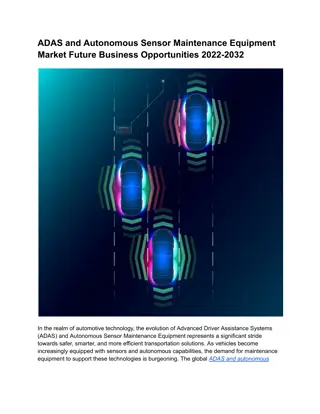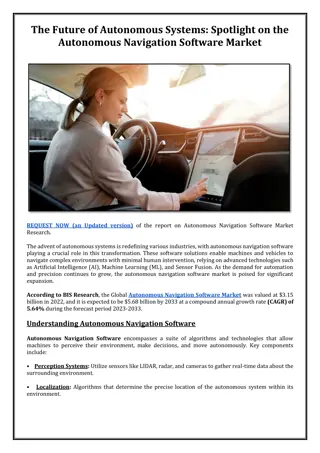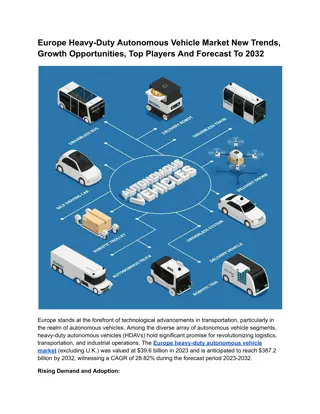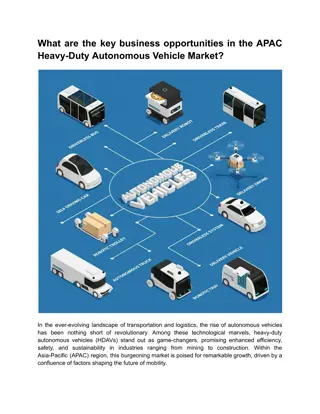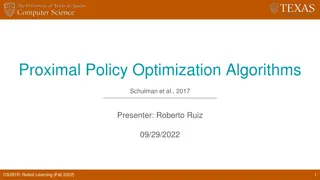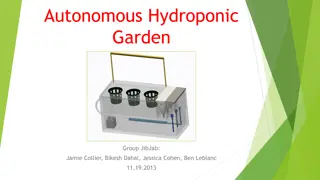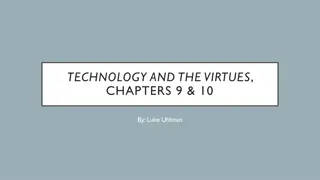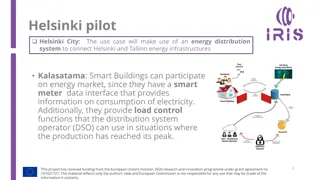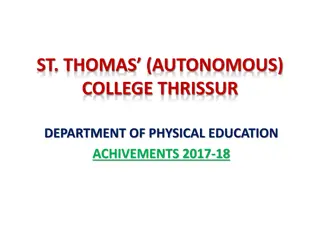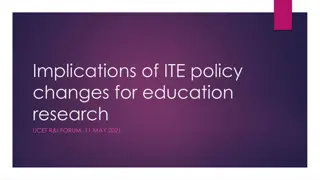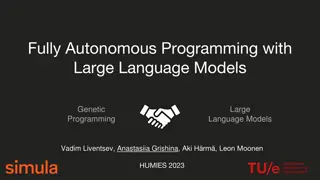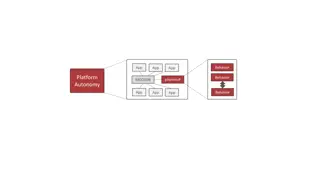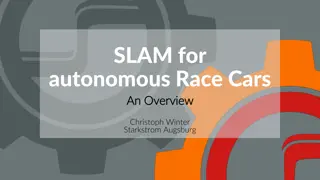Implications of National Education Policy 2020 for Marian College Kuttikkanam Autonomous
The National Education Policy 2020 introduces key changes in the governance of Higher Education Institutions (HEIs), emphasizing research, faculty and institutional autonomy, and restructuring of degree programs. It advocates for institutional consolidation and restructuring, envisioning large, well-resourced, multidisciplinary institutions by 2030. The policy encourages colleges to transition into universities by becoming multidisciplinary and awarding degrees by 2035, with the aim of transforming the educational and economic landscape of the country.
- Education Policy
- Higher Education
- Institutional Restructuring
- Multidisciplinary Institutions
- Degree Programs
Download Presentation

Please find below an Image/Link to download the presentation.
The content on the website is provided AS IS for your information and personal use only. It may not be sold, licensed, or shared on other websites without obtaining consent from the author. Download presentation by click this link. If you encounter any issues during the download, it is possible that the publisher has removed the file from their server.
E N D
Presentation Transcript
NATIONAL EDUCATION POLICY 2020 On Implications for Marian College Kuttikkanam Autonomous Fr Roy Abraham P. MBA, MS, PhD Principal, Marian College Kuttikkanam Autonomous
Key Changes Governance of HEIs light but tight regulation Emphasis on Research Autonomy to Faculty & institutional autonomy Restructuring of Degree Programmes Institutional consolidation and restructuring
Institutional Restructuring & Consolidation New vision - large, well-resourced, multidisciplinary institutions. Two types Consolidation of more than 50,000 HEdn. institutions (800 universities, 44,000 colleges, and others) into about 15,000 large, well-resourced, vibrant multidisciplinary institutions Universities with focus on research and teaching Colleges Autonomous degree-granting colleges Constituent Colleges
Consolidation & Restructuring of Colleges Transition from Colleges to University is not rigid College/University needs to be multi disciplinary Colleges need minimum of 3000 students Time period for transformation of colleges By 2030 become multi disciplinary By 2035 become degree awarding. However, the early adopters will reap their benefits
Institutional Restructuring Large multidisciplinary Universities or HEI clusters is the HIGHEST RECOMMEDATION of this policy Meant for well rounded and innovative individuals Transforming the country educationally and economically
Higher Education Institutions Multidisciplinary University Multidisciplinary College Multidisciplinary by 2030 Degree awarding by 2035
University Means? Definition: A university will mean a multidisciplinary institution of higher learning that offers undergraduate and graduate programmes with high quality teaching, research and community engagement. Programmes Under graduate Graduate Research What it does Teaching Research Community engagement
College Colleges can become Constituent College of a University Autonomous degree awarding colleges Constituent colleges are fully part of the University
Autonomous Degree Awarding Colleges Definition: Autonomous College will refer to a large multidisciplinary institution of higher learning that grants under graduate degrees and is primarily focused on undergraduate teaching. However, it would not be restricted to that and it need not be restricted to that and it would be smaller than a typical University. With appropriate accreditations AC can evolve into: A research intensive University/ A teaching intensive University Types of institutions are not water-tight but are along a continuum.
Changes in Duration UG mul. entry and exit 3 years 4 years 5 year integrated PG PhD 1 year 2 years 5 year integrated After 4 year degree After 1 or 2 year PG B Ed Integrated B Ed -4 years 3 year degree +2 year B Ed. 4 year degree + 1 year B Ed. No more MPhl.
Responsibilities of HEIs Support to school education Faculty development Contribution to different fields of service Community Engagement and Service Support other HEIs to develop Research Teaching
Steps to Autonomy Benchmarks in academic and curricular matters Teaching, learning and assessment Governance reforms Financial robustness Administrative efficiency
Academics Degree Programs shall be holistic, multidisciplinary and of high quality Flexibility in curriculum and novel engaging curriculum options Rigorous specialization a subject/subjects Pedagogy with increased emphasis on Communication Discussion Debate Research Multidisciplinary/inter-disciplinary thinking
Curriculum Definition The curriculum is defined as the inventory of activities implemented to design, organize and plan an education or training action, including definition of learning objectives, content, methods (including assessment) and material, as well as arrangements for training teachers and trainers. (CEDEFOP 2011) Taken from UNESCO website. KUTTIKKANAM PO, PEERMADE, IDUKKI DISTRICT, KERALA, 685531
Academics Internships Credits from value based courses like Research Industry Righteous conduct (Dharma) Peace (Shanti) Love (Prem) Non-violence (Ahimsa) etc. Inclusion of credits from ODL Vocational education
Teaching Learning & Assessment Complete freedom to decide on Curricular aspects Pedagogical methods Assessment Test books and reference materials Broad guidelines can be given by the institution Grading Evaluation Students will most probably be joining for a course rather than a programme
Faculty Related High quality infrastructure No excessive work load Teaching Teacher student ratio No transfer Freedom to design curriculum, decide on pedagogy and assessment Incentives for Research Extension activities Holistic contributions Transparent recruitment Outstanding and enthusiastic institutional leaders Continuous training to Faculty Members Mentoring for Faculty Members
Financial Autonomy Institutions can decide on fees through statutory bodies Should provide for the holistic development of students Substantial increase in the remuneration to Faculty Members Financial allocation for clubs and associations High quality support centres Scholarships to deserving students KUTTIKKANAM PO, PEERMADE, IDUKKI DISTRICT, KERALA, 685531
Governance Reforms & Administrative Efficiency Create necessary governance structures Ensure transparency and efficiency
Possibilities Start multi disciplinary programmes Intensive use of available infrastructure Explore possibilities for ODL Diploma/ Certificate Vocational programs Shift system Should think about merger/Clustering of institutions
Strategic Plan Appropriate curriculum Institutional holistic development plan Achieve global standards 1. Possibility for internalisation 2. Entry of Foreign Universities Inclusion of ODL Support for students
Regulatory Bodies National Higher Education Regulatory Council (NHERC) To bring in equity and transparency in HEIs National Accreditation Council (NAC) Supervising & coordinating the accreditation bodies Higher Education Grants Council (HEGC) Provide financial support General Education Council (GEC) Decide on the outcomes of Educaiton Higher Education Council of India (HECI) Umbrella body to coordinate the other four






